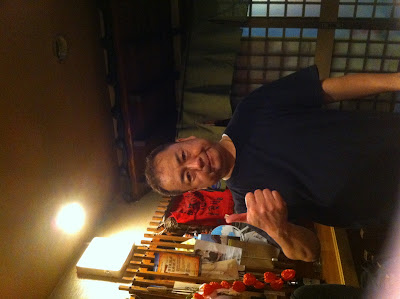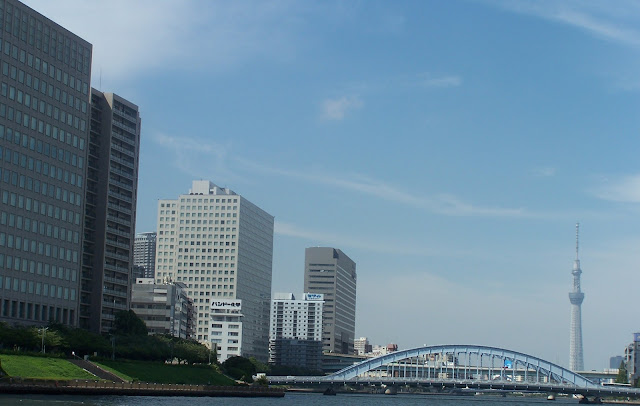So freaking adorable:
Saturday, July 14, 2012
Wednesday, July 11, 2012
Japan Day 11: Asakusa
 |
| Yo getting her lunch tickets. |
1. Tokyo River Cruise
Went to Hinode pier to take the water bus up to Asakusa. We didn't have a lot planned for the day and the river boat ended up being calm and relaxing and a great way to see some of Tokyo.
 |
| The different boats you can take. |
 |
| Ticket from Asakusa to Hinode pier. |
 |
| The sights you see. |
 |
| Mickey and Minnie were very popular. |

 |
| Not sure what this was. Reminds me of a golden turd. |
2. Senso-ji Temple Area
This area was where most of the sights on our list were. It was in a very small area of town, as well as, a very popular area. It was packed with tourists! There were probably more tourists in this one small area than in the whole of what we'd seen throughout Japan. The roads were lined with stores. I finally got my soft serve green tea ice cream.
Yummy!
 |
Senso-ji Pagoda |
 |
| Tons of people in the streets. |
 |
| Large lantern. |
 |
| Bottom of large lantern. Everybody wanted to touch it. |
 |
| Biggest sandal ever. |
 |
| My boy Jang Keun Suk. :) |
 |
| Saibutsu Itabi (1924) Itabi is a type of stupa made of a rectangular stone plate. The top part is shaped in a triangle and an image of Buddha or a syllable that symbolizes Syaka is inscribed. |
 |
| Monument in Memory of Sansho (three haiku master poets) |
 |
| Monchichi everywhere. |
 |
| Had to get one for Charles. |



 |
| Baseball card from Mao (below). |


 |
| Me and Yo in our nightgowns provided by the hotel. |
Tuesday, July 10, 2012
Japan Day 10: Sumida River East, Ueno & Roppongi
1. Edo Tokyo Museum
Took the trains to get to the Edo-Tokyo Museum first thing. THe Monzen-nakacho station was a confusing mess! What a maze. The museum was easy to find though once we got out of the station. Pretty cool museum all about the history of Tokyo. We were able to get through in about an hour and a half but could've probably spent more time.


Ranks and duties: Clothing and rules for each grade and rank were carefully specified by law and custom. Among "household retainers" for example, only the descendants of fudai were allowed to inherit their rank and household headship; nihanba and kakaeire were normally only granted their position for one generation, though nihanba might extend this on appeal. Bannermen were appointed to positions that centered either on military and guard duties (ban kata) or administrative duties (yaku kata). Over half such high-ranking warriors had no official position whatsoever. These jobless samurai were organized into various groups and only paid fees for small construction projects. Warriors were paid in rice.


At the start of the Edo period (1603-1868) the Edo publishing world was dominated by branches of Kyoto publishing houses. But before long, Edo-based bookstores emerged. In 1721 guilds of wholesalers of scholarly books and popular fiction and woodblock prints were formed.








Went to the national museum, which is supposed to have the best collection of Japanese art. When we walked in there was an older Japanese man who waved us over and then made origami for us. He was super fun and cut and excited to be showing us his origami skills. We walked around the museum for a couple hours and saw some really cool art. They had an activity center where we made kimono shaped postcards with a bunch of stamps in different designs.


3. Roppongi Spider
Met Greg in Roppongi and he showed us this huge 10 meter bronze spider (called Maman) in front of the Roku Roku Plaza that was designed by a famous French artist, Louise Bourgeois.








4. The British Pub & Don Quixote
Went to the British Pub for some snacks and drinks and then did some shopping at Don Quixote (or Donkey)!
5. Tokyo Tower
Went to the top of Tokyo Tower (well, almost) and saw a great view of the city. It's a little bit of a tourist trap, but totally worth it. On the mid-observation deck there is a place for you to put your 'love charm' if you go up there with someone special. Cheesy, but cute. My camera and cell phone died by the time we got up there, so I'll have to post some pics later when I get them from Greg and Yo.


Took the trains to get to the Edo-Tokyo Museum first thing. THe Monzen-nakacho station was a confusing mess! What a maze. The museum was easy to find though once we got out of the station. Pretty cool museum all about the history of Tokyo. We were able to get through in about an hour and a half but could've probably spent more time.


 |
| Hand scroll of daimyo procession. |
 |
| High-ranking warriors known as "bannermen" and "household retainers" were divided into numerous ranks. |
Ranks and duties: Clothing and rules for each grade and rank were carefully specified by law and custom. Among "household retainers" for example, only the descendants of fudai were allowed to inherit their rank and household headship; nihanba and kakaeire were normally only granted their position for one generation, though nihanba might extend this on appeal. Bannermen were appointed to positions that centered either on military and guard duties (ban kata) or administrative duties (yaku kata). Over half such high-ranking warriors had no official position whatsoever. These jobless samurai were organized into various groups and only paid fees for small construction projects. Warriors were paid in rice.
 |
| Kyusu teapot |
 |
| Painting of samurai |
 |
| Edo firefighters were established in 1718 to protect the townspeople, and the tradition is stilled passed on today. Standards were symbols for each unit. |
 |
| There were 47 units, each named after a kana character. The "su" unit has been in charge of present-day Tsukiji area in Chuo-kun. |
 |
| Votive picture of firemen of the "sen" group. |
 |
| Firefighters extinguishing fire. |
 |
| News sheet describing the groups of firefighters in Edo. |


At the start of the Edo period (1603-1868) the Edo publishing world was dominated by branches of Kyoto publishing houses. But before long, Edo-based bookstores emerged. In 1721 guilds of wholesalers of scholarly books and popular fiction and woodblock prints were formed.
 |
| During the Edo period, books were printed either with woodblocks or with movable type made of wood or copper. |
 |
| A board game. |

 |
| Different types of currency. Gold and silver coins, as well as zeni, were minted at the gold mint, silver mint and zeni mint. Gold coins were valued by their denomination, silver by their weight. |








 |
| Kimono origami |
 |
| The origami maestro! Loved him. He's blurry 'cause he was so QUICK! |
Katabira (summer garment)
Camelia tree and auspicious Chinese character design.
|
 |
| God of Longevity, Bamboo and Chrysanthemum by Ikeno Taiga (1723-6) |
 |
| Kyogen Mask (wood w/ polychromy) 17th century, Daikoku type |
 |
| Kyogen Mask (wood w/ polychromy) 18th century, Buaku type |
 |
| Kyogen Mask (wood w/ polychromy) 18th century, Buaku type |
 |
| Kyogen Mask (wood w/ polychromy) 18th century, Kobuaku type |
 |
| Kyogen Mask (wood w/ polychromy) 18th century |
 |
| Actor Iwai Hanshiro as courtesan with round fan by Katsukawa Shunsho (1726-92) |
 |
| Inside and Outside the Mosquito Net by Kitagawa Utuinero (1753-1806) |
 |
| Netsuke: Chinese boy with a puppy design. Ivory, 19th century. |
 |
| Netsuke: Five fukujo design Ivory, 19th century. |
 |
| Standing Bishamonten (Vaisravana) |
 |
| Standing Tenno (Deva King) |
 |
| Seated Seishi Bosatsu (Mahasthamaprapta) |

 |
| Standing Juni Shinsho (Twelve Heavenly Generals) |
 |
| Sword guard - Fish design |
 |
| Vessel in Shape of Tiger |
 |
| Mirror, Okinawan |
 |
| Juro (God of Longevity) by Hashimoto Gaho (1835-1908) |
 |
| Footed bowl, with applied crabs and brown glaze by Miyagawa Kozan I (1842-1916) |
 | ||
| Heresy (Trampling a Christian image) by Kobayashi Kokei (1883-1957)
|
Met Greg in Roppongi and he showed us this huge 10 meter bronze spider (called Maman) in front of the Roku Roku Plaza that was designed by a famous French artist, Louise Bourgeois.








4. The British Pub & Don Quixote
Went to the British Pub for some snacks and drinks and then did some shopping at Don Quixote (or Donkey)!
5. Tokyo Tower
Went to the top of Tokyo Tower (well, almost) and saw a great view of the city. It's a little bit of a tourist trap, but totally worth it. On the mid-observation deck there is a place for you to put your 'love charm' if you go up there with someone special. Cheesy, but cute. My camera and cell phone died by the time we got up there, so I'll have to post some pics later when I get them from Greg and Yo.


Enough. Said.
Subscribe to:
Comments (Atom)









































